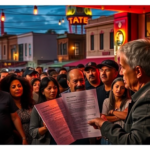Author, Publisher Illuminate Border Realities through “Tiempo, Texas”
In the heart of the Rio Grande Valley, within the walls of the San Benito Cultural Heritage Museum, a discussion unfolded that poignantly captured the complexities and nuances of life along the South Texas border. Author Max Tyrone Lozano and his publisher, Tomas Ray Garcia, shared insights into their decade-long journey of bringing the novel “Tiempo, Texas” to life, offering Valley residents a lens through which to explore their own cultural identity and migration narratives.
The Story Behind “Tiempo, Texas”
“Tiempo, Texas” is not just a novel; it’s a tapestry of intertwined lives, challenges, and dreams that echo the realities of border life. Set along the Texas-Mexico border, this book took ten years to complete and was published by Garcia’s Beyond Borders Books. The narrative is a collection of vignettes that delve into the experiences of characters grappling with cultural identity and the invisible but ever-present lines between past and present.
During their presentation, Lozano and Garcia refrained from revealing too much about the characters, instead opting to draw parallels between the fictional world and the real lives of those residing in the Valley. This artistic restraint allowed attendees to reflect on their own lives while maintaining an air of mystery around the characters, such as Luis Ruiz, who dreams of reuniting with his mother, and Freddy Quintanilla, bearing the weight of familial obligations.
A Voice from the Borderlands
Lozano and Garcia emphasized the duality faced by Valley residents—of improving life circumstances and remaining tethered to familial roots. Described as a fronterizo writer, Lozano’s work highlights the ongoing conflicts and decisions faced by those straddling two cultures and nations.
“Growing up, many of us had dreams of leaving for places like Austin,” Lozano recounted. Yet even with educational journeys that took him away, receiving education first in College Station and then at the University of Texas system in Edinburg, the Rio Grande Valley’s heartbeat remained with him. “Tiempo, Texas,” therefore, becomes a living testament to those who stayed, those who left, and those torn from their homes through deportation.
Garcia added, “This novel introduces a new voice in the literary landscape. It’s rooted in history and constantly evolving—a reminder of the shared experiences across this borderland.”
Engaging the Community
Beyond the literary realm, the presentation touched on broader community themes. The Valley is not new to conversations about migration, identity, and cultural preservation. The recent return of ResacaFest to Heavin Trail and workshops at local museums underscore the community’s dedication to cultural engagement.
“Tiempo, Texas” aligns with ongoing dialogues in San Benito about environmental issues, as seen in discussions around the San Benito Wetlands. The interconnectedness of cultural and ecological topics signifies a recognition that all parts of the Valley’s landscape—people, land, and history—are indelibly linked.
Transformative Impact on Valley Residents
For Valley residents, the publication and discussion of “Tiempo, Texas” represent more than just a novel. It’s a tapestry stitched with the threads of shared experiences and aspirations, providing a literary bridge across which they can navigate their own migration stories.
Josefina Rodriguez, a local educator who attended the talk, found the book’s themes resonating with her students. “The book provides a space where our young people can see snippets of their own lives and dreams reflected,” she explained. This ability to mirror the community’s experiences offers empowerment, a critical component in fostering understanding and empathy.
Looking Ahead
As “Tiempo, Texas” continues to weave its way through the consciousness of Valley residents, it presents a foundation upon which further literary exploration and cultural dialogue can build. Lozano and Garcia’s collaboration highlights the enduring power of storytelling to illuminate the human condition in regions marked by geographical and cultural divides.
In the future, such narratives may stimulate discussions across policy tables and community gatherings, influencing how the Valley crafts its identity amid shifting socio-political landscapes. For now, however, the book stands as a testament to the Valley’s resilience, telling its stories with authenticity and humanity.
To obtain a copy of “Tiempo, Texas,” interested readers can visit Beyond Borders Books’ website. As the book finds its home on shelves and in the hearts of its readers, it cues up a larger conversation about the past, present, and future of the Rio Grande Valley.







